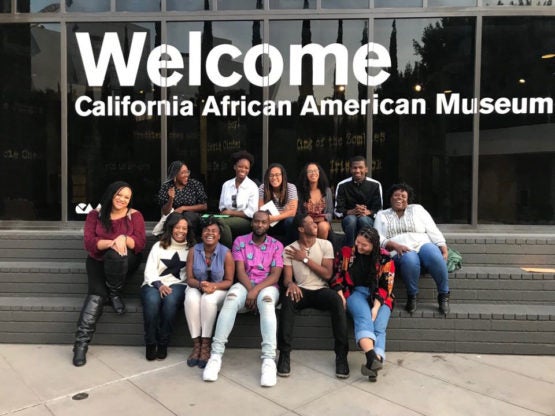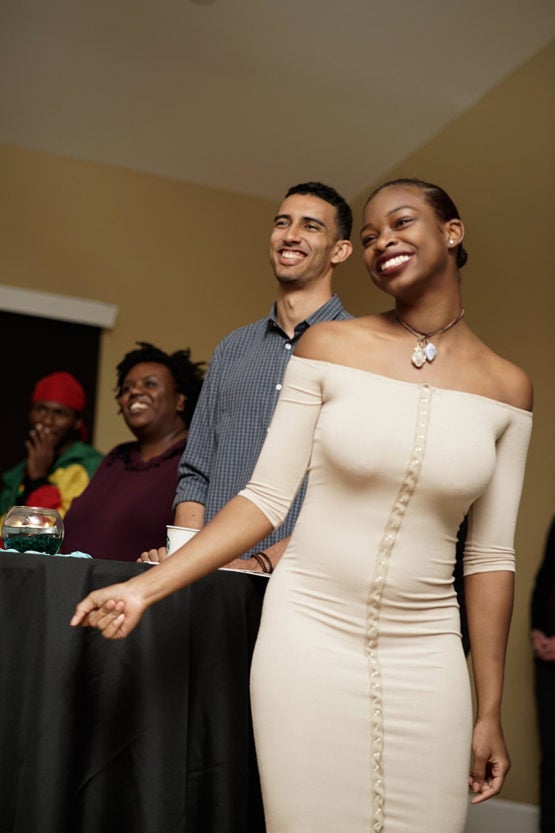Stanford’s African and African American Studies program turns 50
Stanford’s first ethnic studies program celebrates its 50th anniversary by bringing leading scholars in black studies to campus for a conference in April.
Stanford junior Dayonna Tucker still remembers feeling unsure during Admit Weekend what her future studies would look like.

Students in the African and African American Studies program visit the California African American Museum in Los Angeles in 2017. (Image credit: Victor Bashorun)
But she said that hesitancy quickly dissipated once she discovered Stanford’s Program in African and African American Studies (AAAS), a place she and several other students call “a home away from home.”
“Studying my heritage and where I come from has directly increased my self-esteem and how I see African American communities,” said Tucker, who is majoring in AAAS and minoring in creative writing. “The biggest reward has been the connections I’ve made with the program’s faculty, students and staff. We are all like family to each other.”
This winter quarter, the Program in African and African American Studies marked 50 years since its first cohort of 13 Stanford undergraduates began their coursework.
The interdisciplinary program offers a major and a minor in the study of history, culture and sociology of African Americans and people in the African diaspora. It is the oldest ethnic studies program developed at Stanford and the first African and African American Studies program created at a private institution in the United States.

Members of the Black Student Union take the stage and microphone during a program following the assassination of Martin Luther King, Jr., April 8, 1968. (Image credit: Stanford University Archives)
“We strive to create a place where students of all backgrounds could have conversations about racial justice, equity and how to make the world a better place,” said Allyson Hobbs, director of the program and associate professor of American history in the School of Humanities and Sciences at Stanford.
Hobbs emphasized the importance of studying African and African American history in a time when racial disparities still exist across society, from education to health care and criminal justice systems.
“There is a kind of salience to the study of African and African American studies now given our political climate,” Hobbs said. “Delving deeper into the history and culture of African Americans and the African diaspora can broaden people’s understanding and awareness of our country’s past and current issues.”

Stanford junior Dayonna Tucker celebrates Black History Month with other students at an annual event organized by the Program in African and African American Studies in 2018. (Image credit: Victor Bashorun)
The program’s roots date to the campus gathering in Memorial Auditorium in the wake of Martin Luther King Jr.’s assassination in April 1968. During the event, 70 members of Stanford’s Black Student Union famously ascended the stage, took the microphone from then-Provost Richard Lyman and read a list of 10 demands that asked the university to boost African American admissions, curriculum and hiring. Shortly after, a committee headed by professor emeritus of anthropology James L. Gibbs developed the program.
The original demands of the students are still at the heart of the program’s mission today, Hobbs said.
Hobbs said her goals include helping Stanford hire more black professors and scholars with a focus on African American studies. She is also helping to bolster the involvement of Stanford graduate students in black studies and she hopes the program could one day provide a PhD track. This year, under her directorship, the program has for the first time hired two postdoctoral researchers.
“We are proud of our history,” Hobbs said. “But there is still work to do as we look ahead.”
Students praised the AAAS faculty and administrators for providing them with opportunities to not only pursue their intellectual curiosities but also to explore their own identity and connect with each other.
“At a huge place like Stanford, it can be easy to feel lost in the crowd,” said Stanford senior Nya Hughes, who is majoring in communication and African and African American studies. “AAAS gave me a home base that’s been really valuable intellectually and personally throughout my undergraduate years.”
Throughout each academic year, students participate in various events and traditions. For example, every Black History Month is kicked off with a night of poetry readings and live music at the Black Community Service Center. Students also go on field trips and connect with their peers over casual dinner debriefings where they talk about their classes and experiences. In recent years, students have visited the National Museum of African American History and Culture in Washington, D.C., and the California African American Museum in Los Angeles.
As an aspiring political leader and organizer, Stanford sophomore Kory Gaines said his two majors, political science and AAAS, are giving him a breadth of skills and knowledge he couldn’t have obtained another way.
“It’s been incredible to immerse myself in the history, literature and culture that’s at the foundation of how our nation was created,” Gaines said. “I’m proud of being a part of AAAS and part of the legacy of taking back the mic.”
